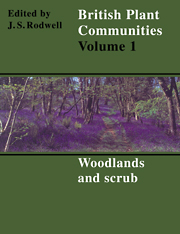Book contents
- Frontmatter
- Contents
- List of Figures
- Foreword
- Preface and Acknowledgements
- Preamble
- General Introduction
- Woodlands and Scrub
- Introduction to Woodlands and Scrub
- Key To Woodlands and Scrub
- Community Descriptions
- W1 Salix Cinerea-Galium Palustre woodland
- W2 Salix Cinerea-Betula Pubescens-Phragmites Australis Woodland
- W3 Salix Pentandra-Carex Rostrata Woodland
- W4 Betula Pubescens-Molinia Caerulea Woodland
- W5 Alnus Glutinosa-Carex Paniculata Woodland
- W6 Alnus Glutinosa-Urtica Jzozca Woodland
- W7 Ainus Glutinosa-Fraxinus Excelsior-Lysimachia Nemorum Woodland
- W8 Fraxinus Excelsior-Acer Campestre-Mercurialis Perennis Woodland
- W9 Fraxinus Excelsior-Sorbus Aucuparia-Mercurialis Perennis Woodland
- W10 Quereus Robur-Pteridium Aquilinum-Rubus Fruticosus Woodland
- W11 Quereus Petraea-Betula Pubescens-Oxalis Acetosella Woodland
- W12 Fagus Sylvatica-Mercurialis Perennis Woodland
- W13 Taxus Baccata Woodland
- W14 Fagus Sylvatica-Rubus Fruticosus Woodland
- W15 Fagus Sylvatica-Deschampsia Flexuosa Woodland
- W16 Quereus spp.-Betula spp.-Deschampsia Flexuosa Woodland
- W17 Quereus Petraea-Betula Pubescens-Dicranum Majus Woodland
- W18 Pinus Sylvestris-Hylocomium Splendens Woodland
- W19 Juniperus Communis Ssp. Communis-Oxalis Acetosella Woodland
- W20 Salix Lapponum-Luzula Sylvatica Scrub
- W21 Crataegus monogyna-Hedera helix scrub
- W22 Prunus Spinosa-Rubus Fruticosus Scrub
- W23 Ulex Europaeus-Rubus Fruticosus Scrub
- W24 Rubus Fruticosus-Holcus Lanatus Underscrub
- W25 Pteridium Aquilinum-Rubus Fruticosus Underscrub
- Index of Synonyms to Woodlands and Scrub
- Index of Species in Woodlands and Scrub
- Bibliography
W1 - Salix Cinerea-Galium Palustre woodland
Published online by Cambridge University Press: 04 July 2020
- Frontmatter
- Contents
- List of Figures
- Foreword
- Preface and Acknowledgements
- Preamble
- General Introduction
- Woodlands and Scrub
- Introduction to Woodlands and Scrub
- Key To Woodlands and Scrub
- Community Descriptions
- W1 Salix Cinerea-Galium Palustre woodland
- W2 Salix Cinerea-Betula Pubescens-Phragmites Australis Woodland
- W3 Salix Pentandra-Carex Rostrata Woodland
- W4 Betula Pubescens-Molinia Caerulea Woodland
- W5 Alnus Glutinosa-Carex Paniculata Woodland
- W6 Alnus Glutinosa-Urtica Jzozca Woodland
- W7 Ainus Glutinosa-Fraxinus Excelsior-Lysimachia Nemorum Woodland
- W8 Fraxinus Excelsior-Acer Campestre-Mercurialis Perennis Woodland
- W9 Fraxinus Excelsior-Sorbus Aucuparia-Mercurialis Perennis Woodland
- W10 Quereus Robur-Pteridium Aquilinum-Rubus Fruticosus Woodland
- W11 Quereus Petraea-Betula Pubescens-Oxalis Acetosella Woodland
- W12 Fagus Sylvatica-Mercurialis Perennis Woodland
- W13 Taxus Baccata Woodland
- W14 Fagus Sylvatica-Rubus Fruticosus Woodland
- W15 Fagus Sylvatica-Deschampsia Flexuosa Woodland
- W16 Quereus spp.-Betula spp.-Deschampsia Flexuosa Woodland
- W17 Quereus Petraea-Betula Pubescens-Dicranum Majus Woodland
- W18 Pinus Sylvestris-Hylocomium Splendens Woodland
- W19 Juniperus Communis Ssp. Communis-Oxalis Acetosella Woodland
- W20 Salix Lapponum-Luzula Sylvatica Scrub
- W21 Crataegus monogyna-Hedera helix scrub
- W22 Prunus Spinosa-Rubus Fruticosus Scrub
- W23 Ulex Europaeus-Rubus Fruticosus Scrub
- W24 Rubus Fruticosus-Holcus Lanatus Underscrub
- W25 Pteridium Aquilinum-Rubus Fruticosus Underscrub
- Index of Synonyms to Woodlands and Scrub
- Index of Species in Woodlands and Scrub
- Bibliography
Summary
Synonymy
Salix carr Willis & Jefferies 1959 p.p.; Salix cinerea carr Wheeler 1980c p.p.; Woodland plot type 32 Bunce 1982; Scutellaria galericulata-Alnus glutinosa Association Birse 1982 p.p.
Constant species
Salix cinerea, Galium palustre.
Rare species
Lysimachia thyrsiflora.
Physiognomy
The Salix cinerea-Galium palustre woodland has a canopy dominated by 5. cinerea but stands vary considerably in their overall appearance. Where invasion is more recent, there can be a confused mass of bushes of varying height and density but older stands have a more even look with usually a single tier of sallows forming a canopy 4—8 m high. Here, there can be an abundance of standing dead wood beneath, where thickly-set colonising bushes have been shaded out by the developing survivors, but long-established sallows, especially multistemmed individuals which form broadly-spreading crowns, usually cast a light shade.
The commonest woody associate, though it is still no more than occasional, is Betula pubescens and scattered trees of this species, together with scarcer Alnus glutinosa, Quercus robur and Betula pendula, sometimes break the sallow canopy, reaching 10-15 m. Other Salices are uncommon (there are sometimes records for the osiers, S. viminalis and 5. purpurea) but there can be scattered bushes of Crataegus monogyna, Corylus avellana and Frangula alnus. Saplings of Betula pubescens, Quercus robur and Alnus occur very occasionally.
The field layer varies in its cover and composition but the general appearance is of an open scatter of herbs with different species attaining occasional local prominence. Quite commonly there are mosaics developed in relation to canopy gaps and over undulations of wetter and drier ground. The commonest species throughout is Galium palustre but Mentha aquatica and Juncus effusus are also frequent, the latter sometimes forming large tussocks in lighter shade. Then, there are scattered plants of Angelica sylvestris, Ly copus europaeus, Ranunculusflammula, R. repens, Epilobiumpalustre, Equisetum fluviatile, Filipendula ulmaria, Cirsium palustre and Rumex sanguineus. Less common, though sometimes abundant, are Caltha palustris, Hydrocotyle vulgaris, Potentilla palustris and Iris pseudacorus and, in North Yorkshire and central Scotland, the national rarity Lysimachia thyrsiflora occurs (e.g. Birse 1982). In some stands, there may be much Rubus fruticosus agg.
- Type
- Chapter
- Information
- British Plant Communities , pp. 48 - 51Publisher: Cambridge University PressPrint publication year: 1991



